The area of the Russian segment of the Arctic territories is about 9 million square kilometers. Of these, only about 2.2 million square kilometers belong to land, the rest of the area is made up of the seas and the Arctic Ocean. The prevalence of land areas on large area allows the Arctic to capture several natural zones, each of which has its own characteristic features of climate and plants - from the northernmost territories of the icy Arctic deserts, where a very limited list of flora representatives can survive, to tundra and forest-tundra, which are distinguished by a much greater species diversity.
What plants are in the Arctic
Northernmost natural area high latitudes - arctic deserts. These include a large part of the Arctic island territories. The landscape of this area is based on snow, ice and stone deposits. The earth receives a very meager amount of solar energy - less than 400 mJ / m2, also characterized by a small amount of precipitation - 200-400 mm, mostly solid, high, up to 85% humidity and strong winds. All this does not contribute to the development of rich species diversity.
The vegetation cover has a sparse, focal character - the dominant lichens and mosses in this area prefer areas sheltered from the winds and cover 1-3% of soils in the zone of ice deserts and up to 65% on the border of tundra. The flora of the Arctic is scarce in the north of the Arctic deserts - it is mainly inhabited by lichens - cladonia (Cladonia thomsonii, etc.), nephroma (Nephroma parile), Parmelia (Parmelia fraudans, Parmelia saxatilis) and others, hypnum and sphagnum mosses.
Higher flora specimens are few in number and grow in fertilized areas sheltered from cold winds (bird colonies, lemming burrows). It's easy to list the names flora The arctic of this zone: alpine foxtail, snow saxifrage, arctic buttercup, arctic pike, polar poppy, sow thistle, bluegrass, crumble, starlet, polar willow grow here. They all rarely reach more than 3-5 cm in height.
Separately, one can single out such plants of the Arctic as algae, which occupy the underwater areas of the northern seas and the Arctic Ocean and have up to 150 species. Some of the underwater species in the Arctic have economic value... For example, the kelp kelp, which we know as "seaweed", lives in the Arctic.
Tundra natural zones are located to the south, in milder climatic conditions - mainly on the coastal continental territories, and the list of Arctic plants is much wider here. Along with mosses and lichens, such as reindeer moss, or deer moss (as the name implies, which is the main food for reindeer), higher plants are common here - from foxtail, saxifrage, cereals, known from the Arctic desert, to creeper shrubs and others. Shrubs of dwarf birch, willow, alder are also widespread here.
Among the shrubs, there are also those that are of economic importance - parts of plants and berries of lingonberries, cloudberries are suitable for food, are used in medicine and cosmetology.
Everything that grows in the Arctic of this zone is characterized by low growth, creeping shrubs, the root system is slightly deepened into the ground. These features of plants in the Arctic are due to climatic conditions - permafrost under a thin layer of soil and strong winds which damage the branches peeping out from under the snow cover with the carried masses of snow.
There are plants in the Arctic that rise above the bushes, they belong to the forest-tundra zone - a narrow strip on the border of tundra and forests. A feature of the flora of the Arctic in this natural zone is the presence of sparse, but real forests. Arctic plants - grasses, shrubs, shrubs, mosses and lichens are here side by side with Siberian and Daurian birch, larch, spruce. Permafrost, winds and a harsh climate explain the sparse nature of the trees growing here.
Fungi are widely represented among Arctic plants - from numerous microscopic species that are of interest only to specialists, to macromycetes, known to us as edible (or inedible) mushrooms, they grow in the Arctic mainly in the tundra and forest-tundra zones.

List of rare plants in the Arctic
One of the features of this harsh, uncomfortable, but beautiful and very promising in terms of economic activity human edge - an abundance of rare and endemic plants in the Arctic, combined with an extremely weak resistance of ecosystems to the influence of external influences. Low temperatures, extremely small proportion solar radiation, which goes to these zones, determine the low productivity of the local flora. The soil will take years or decades to heal the wound in the vegetation left by the tractor caterpillars. Environmental factors also have a strong impact on the flora - pollution of water, soil, air, which occurs due to the location in the region of the extraction and processing of various minerals, including toxic ones (nickel), pollution of the area by waste of human economic activity.
The Red Data Books of Russia and individual regions contain such names as:
- polar poppy;
- arctic castille;
- dense-flowered gill (arctic woodworm);
- dryopteris golokuchnik;
- several types of cladonia;
- cotoneaster cinnabar red;
- stone sedge;
- ice grains;
- bluegrass gray and shortened;
- Svalbard buttercup;
- northern flax;
- ice buttercup;
- saxifrage stiff-leaved and soddy;
- myrtle willow;
- Evenk thyme - endemic;
- small petals complex;
- purple core.
For example, such plants as the arctic sunflower and the Turiemys dandelion grow only on the Turie cape, which is part of the Kandalaksha nature reserve. Also, on the territory of this reserve alone, the lady's slipper, the leafless caper and more than 20 species of plants protected in the territory of the region or the country as a whole grow.
Wrangel Island is characterized not even by individual protected plants, but by whole plant communities of a relict nature, belonging to the ancient Pleistocene, which are protected and studied by the staff of the reserve. In addition, the Arctic is incredibly rich in endemics; they are found both in the animal kingdom and among vascular plants, lichens, and mosses.
Only insignificant parts of the land thaw on stony and marshy soils, where you can find small "oases" - isolated areas with crustacean mosses, lichens, as well as herbaceous plants (sow thistle, cereals). In these harsh conditions of the kingdom of eternal snow and ice, there are even some flowering specimens of typical endemics - in the form of an alpine foxtail (Latin Alpine alpinus), Arctic pike (Latin Deschampsia arctica), buttercup (Latin Ranunculus sulрhureus), snow saxifrage (Lat. Saxifraga nivаlis), polar poppy (lat.Papaver polare), diluting the scarcity of the surrounding nature with bright strokes.
Mushrooms and berries (cloudberries, cranberries, lingonberries) are rare.
The entire main flora of higher arctic plants does not exceed 350 species.
The flora of the ice zone is an arctic desert, with a torn cover (total coverage approximately 65%). On mountain tops, on inner plateaus and moraine slopes, the coverage area is no more than 1-3%.
Although the vegetation in the arctic deserts is poor and monotonous, you can notice a change in its character if you move from northern to southern borders... The north of Franz Josef Land, Severnaya Zemlya, the north of Taimyr is the territory where the grassy-moss arctic desert is developed. In the south of Franz Josef Land, the northern island of Novaya Zemlya, the New Siberian Islands, you can observe depleted shrub-moss arctic deserts, the vegetation cover of which includes low shrubs of polar willow (Latin Salix polaris) and saxifrage (Latin Saxifraga oppo-sitifotia). In the south of the ice zone, the most widespread arctic deserts are the dwarf-moss type, in which the dwarf shrub layer of the arctic willow (Latin S. arctica), polar willow, and dryad (Latin Dryas punctata) are well developed.
Low summer temperatures, scarce flora and permafrost layer interfere with the normal soil-forming process. During the season, the thawed layer does not exceed 40 cm. The soil thaws only in the middle of summer, and by the beginning of autumn it freezes again. Waterlogging during the thawing period and drying out in summer lead to cracking of the soil cover. In most of the Arctic, there are almost no formed soils, but only coarse detrital material in the form of placers. Lowlands and their fine earthy soil are the basis arctic soils(very weak, without any signs of worming). Arctic ferruginous, slightly acidic, almost neutral, soils are brown in color. These soils are complex, associated with microreliefs, soil composition and vegetation. Scientific quote: "the main specific feature of the Arctic soils is that they are like a" complex "of soils with a normally developed profile under plant sod and with a reduced profile under algal soil films" gives full description arctic soils and explains the peculiarities of the flora of this region.
Productive vegetation in the Arctic is negligible. The total phytomass never exceeds 5 t / ha. The living aboveground mass sharply prevails over its underground part, distinguishing the Arctic desert, for example, from tundra, temperate or subtropical deserts with an inverse ratio of underground and aboveground phytomasses.
Algae (about 150 species) stand out as a separate group. The changed climate of the Arctic has dramatically changed the bottom ecosystems in the fjords of Svalbard: over 30 years, the algae cover there began to occupy an area 5-8 times larger when compared with the beginning of observations. If in 1995 the share of the Kongsfjord algae cover did not exceed 8% of its area, then already 1996 became abnormal for brown algae (which are called kelp, in common parlance - seaweed) - they suddenly occupied 80% of the total area, and since that time they have not inferior to the mark at the level of 40%.
Smeerenburgfjord was "captured" by both brown and red algae after 5 years. There, the algae cover has grown from 3% to 26%.
On the fjords, kelp has strongly pushed the previous dominants - anemones (sea anemones) and invertebrates.
The changed climate of the Arctic managed to reduce the stability of its bottom ecosystems, brought them out of a balanced state, and “opened”, that is, bottom ecosystems for more thermophilic species.
In addition, algae cause snow and ice to bloom. Their color is very diverse - from green, yellow, blue, brown to black, which depend on the presence in them of some type of snow algae and other microorganisms.
Only "ice" diatoms in northern zone seas are now recorded about 80 different species.
Such algae can adapt to extremely unfavorable living conditions in low temperatures... When they are in very cold surface layers of snow cover and glaciers, they experience very strong cooling from winter air temperatures of several tens of minus degrees, and in summer they can multiply in melted ice water, at 0 ° C. Scientists cannot explain this: for example, snow Chlamydomonas has a dormant stage with round thick-walled cells, and many other algae, including diatomy, have no special adaptation to withstand such low temperatures.
These algae of snow and ice belong to the vast majority of organisms that settle in frozen substrates. This type of substrates has received the general name cryobiotopes (from the Greek cryo-cold, and topos - place), and their settlers are called cryobionts.
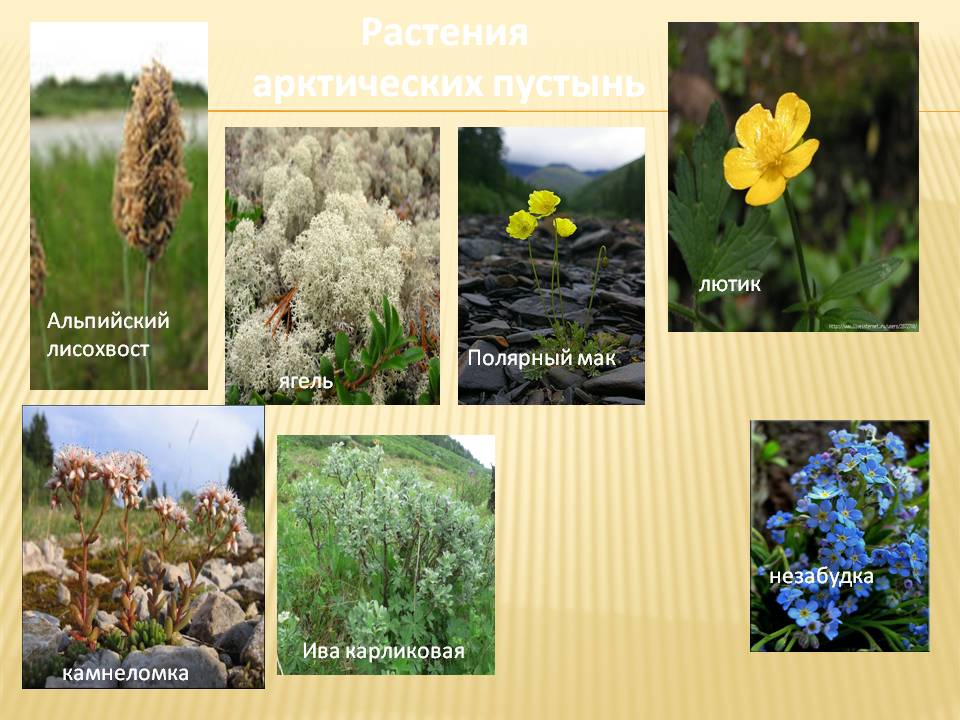
The sun's rays only glide along their surface, giving little heat, because the sun never rises high here (Fig. 2).
Rice. 2. Arctic Sun ()
The Arctic has a very harsh climate: snow and ice lie almost all year round, winters are very long and frosty (up to -60 °), hurricane winds blow, and a blizzard rages for several weeks in a row. From mid-October, the sun is no longer visible - the long polar night begins (lasts up to 6 months). Sometimes during the polar night there are polar lights, which last from several minutes to several days and are so extensive that their light is sufficient even for reading (Fig. 3).
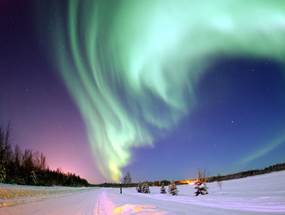
Rice. 3. Aurora Borealis ()
At the end of February the sun appears and the day begins to arrive. And from mid-May to mid-June, the sun does not hide at all - the polar day begins. But even at this time, the temperature rises only a few degrees above zero.
The islands are so poor in vegetation that they are called arctic deserts... On the stones meet moss, lichens, polar poppy and some other plants (Fig. 4-6).
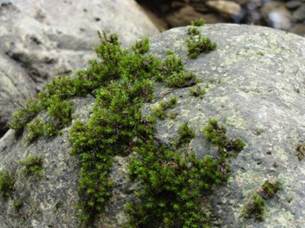
Rice. 4. Mosses on a stone ()
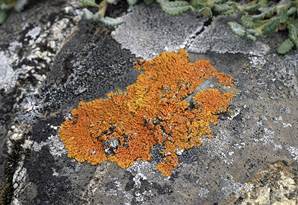
Rice. 5. Lichens on the stone ()
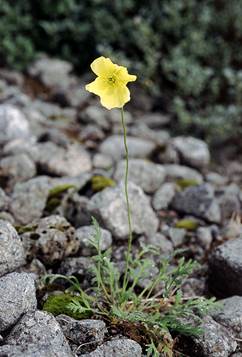
Rice. 6. Polar poppy ()
All plants here are dwarfs, their height is no more than 10 cm, only polar willow reaches 1 m (Fig. 7).
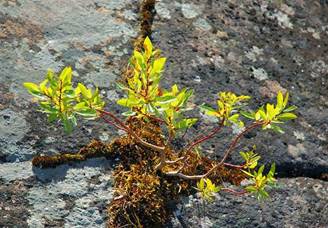
Rice. 7. Arctic willow ()
But all plants, protecting themselves from the cold and wind, are forced to cuddle to the ground.
The sea feeds all the inhabitants of the ice zone. In water rich in oxygen and carbon dioxide, they actively reproduce algae and crustaceans- the first link in the food chain arctic zone(fig. 8).

Rice. 8. Algae, crustaceans and other inhabitants of the ocean ()
They feed on fish and birds. Birds gather in large flocks, settle on rocks, and, despite the tightness and size of the flock, each bird unmistakably finds its nest (Fig. 9).

Rice. 9. Nesting guillemots ()
Guillemots- noisy birds that nest on sheer cliffs, where no animal can reach (Fig. 10).
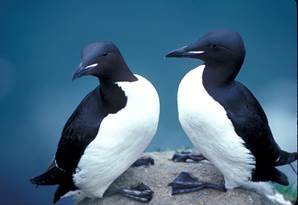
Guillemots hatch only one cone-shaped egg each (this shape protects the egg from falling from high cliffs). When the chick grows up, the guillemot throws it into the water, where its adult life begins: guillemots are excellent swimmers and divers (in the water they develop speeds up to 20 km / h, reaching a depth of 140 m).
Seagulls also adapted to the conditions of the Arctic: they fly well, swim well, but dive poorly (Fig. 11).
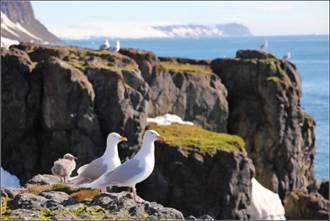
On some islands, you can see a huge number dead ends(fig. 12).

These are beautiful silent birds with an unusual beak. For living, they choose islands with a thick layer of peat, in which they dig their nests with the help of clawed paws and beaks. A dead end is an excellent getter: it can stay under water for up to 30 seconds, chasing fish, and bring up to 10 fish to the nest at a time.
Another food chain is algae - crustaceans - whales(fig. 13).

These huge animals are perfectly adapted to life in the ice zone: a waterproof hide and a thick layer of fat under it protect them from the cold.
Seals- one more inhabitants of the Arctic, live both on land and in water (Fig. 14).
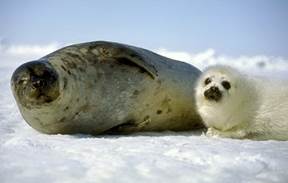
They are great swimmers. They need up to 16 kg of food per day. At the end of winter, seals give birth to snow-white cubs - seals. The white color helps kids to hide, disguising themselves as snow in order to escape from enemies, primarily from a polar bear. And adult seals escape from their main enemy in the water, because on land they are slow and clumsy.
Polar bear called the king of the Arctic, the great traveler and hunter (Fig. 15).
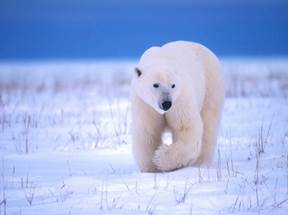
Rice. 15. Polar bear ()
This animal has perfectly adapted to life in the ice zone: it is fast and agile on land and in water, strong, it has an excellent sense of smell, thick white hair and wide paws with sharp claws. Like all inhabitants of the Arctic, he has small ears - so as not to freeze. For the winter, female mothers lie in snow dens, where cubs are born to them (most often there are two cubs, they are small, the size of a mitten). The mother bear feeds and warms them. In the spring, the cubs will leave the den, but for another two years, the bear will teach her cubs to fish, hunt seals and much more (Fig. 16).
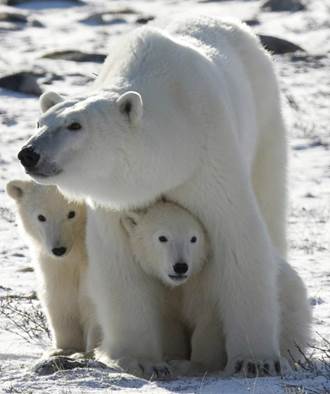
Rice. 16. Polar bear with cubs ()
The fauna of the Arctic is unique. A nature reserve was created on Wrangel Island - here are the largest concentrations walruses(fig. 17).
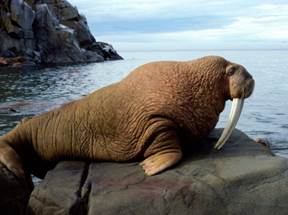
Walrus tusks- a universal weapon in the production of food and a weapon in defense from the enemy, as well as an insignia (who has the largest and most powerful tusks, he is the main one). There is a thick mustache on the face of the walrus - vibrissae- with the help of which they find food at the bottom of the sea (Fig. 18).
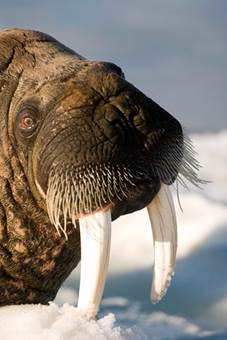
Rice. 18. Vibrissae on the walrus face ()
You can also see in this reserve musk ox(fig. 19).
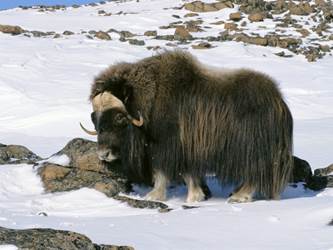
Rice. 19. Musk ox ()
Once they lived on the territory of Russia, but then they disappeared, and scientists brought them to Wrangel Island from North America (this is how rare and endangered species of animals are preserved).
This reserve is also called the maternity hospital of polar bears - bears come here from all over the Arctic, scientists count up to 250 dens per year.
For many years, the Arctic has been attracting people who, risking their lives, in extreme conditions, explore its expanses, make maps (Fig. 20).
Bibliography
- Vakhrushev A.A., Danilov D.D. The world around you 3. - M .: Ballas.
- Dmitrieva N.Ya., Kazakov A.N. The world around us 3. - M .: Publishing house "Fedorov".
- A.A. Pleshakov The world around us 3. - M .: Enlightenment.
- Geo-site.ru ().
- Biofile.ru ().
- Do.gendocs.ru ().
Homework
- Write a short quiz (6 questions with three possible answers) on the Arctic Desert Zone.
- Prepare small message about one of the animals in the Arctic.
- Consider how the appearance and habits of a brown bear would change if it lived in an arctic desert zone.
- * Using the knowledge gained in the lesson, compose a small (10 questions) crossword puzzle on the topic "Arctic".
The zone of arctic deserts is located in the very north of the continents of Eurasia and North America... The climate and living conditions here are very harsh, there is no change of seasons as such. There is a polar night, during which the temperature is kept in the range of 30-40 degrees below zero. During the day in this region, the air warms up to -10, sometimes to -3 degrees. That is why the animals of the Arctic deserts are fundamentally different from those that live in our continental latitudes Oh. They are more adapted to survive in harsh conditions. Well, about what they are, how they are characteristic and how popularized, read below.
Feathered permanent residents of the Arctic
For the most part animal world arctic deserts are represented in the form of birds. The feathered fauna is represented here by 124 different species of sky inhabitants, 55 of which consider the Arctic as their home and nest there. Among these sedentary northern birds, one can distinguish the rosé gull, Siberian eider, and guillemot. By the way, representatives of the latter species prefer to nest at the heights of various rocks that are covered with glaciers. However, they do not experience discomfort. Also, the bird fauna of the Arctic deserts is presented in the form of glaucous gulls, ivory gulls, polar terns, purses, luriks, etc. The queen among the permanent residents of the northern skies is
Fickle inhabitants of the arctic skies
When day comes in the very north of our planet and the air temperature rises, birds from the tundra, taiga and continental latitudes come here. Therefore, from the beginning of the first warm days on the shores of the Arctic Ocean, you can meet black geese, neckties, tules, brown-winged plovers, white-tailed sandpipers. With them, flocks of the following birds fly here: sandpiper, red-breasted dunl, dunlin, uphill-legged buzzard and many others. With the onset of cold weather, all of the above flocks return to more southern latitudes. But this does not mean at all that the fauna of the Arctic deserts is becoming more scarce. Birds fly over this region constantly, and, perhaps, it is thanks to the birds that these lands still show even the slightest signs of life. 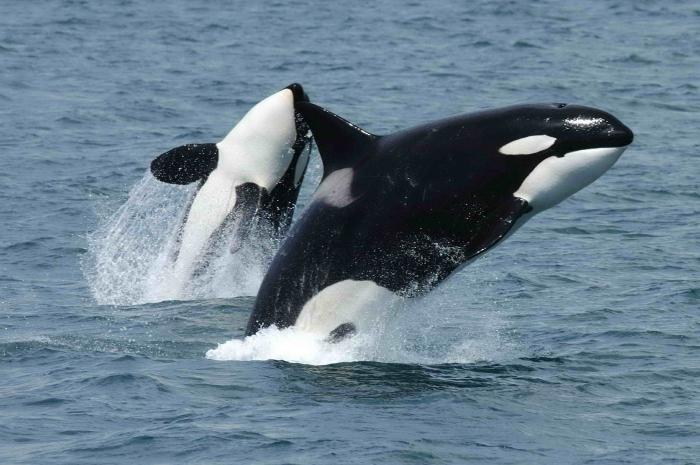
General description of mammals
The animals of the Arctic desert zone, which live on land or lead a semi-aquatic lifestyle, are only 16 species. 4 of them are representatives of the marine fauna, but they are not fish, but still mammals. More than half of them are listed in the Red Book Russian Federation... For this reason, hunting in the arctic deserts is strictly prohibited, and every individual who is a representative of the fauna is carefully protected by the government. So, now we will take a closer look at each inhabitant of these latitudes and find out what characteristics they have. 
Inhabitants of the icy depths
To begin with, let's consider what we have living in cold waters of the animals of the Arctic deserts. We often met photos of many of them on the pages of Soviet textbooks or just saw them on TV. The most interesting inhabitant of the region is the narwhal. A huge fish that reaches a length of 5 meters and weighs more than one and a half tons. Characteristic feature is the long horn that sticks out of the mouth. It is like a tooth of an animal, but it does not fulfill its inherent functions. Narwhals are the only animals of their kind and have no analogues. The closest relative of this species is the bowhead whale. It is much more massive than a narwhal, but does not have such a huge tooth. It feeds on plankton and swims far enough in the sea. The next marine mammal of the northern regions is the beluga or polar dolphin. It lives at great depths of the ocean and feeds exclusively on fish. Our list is completed by the most dangerous northern underwater predator - the killer whale. In addition to the fact that it devours the smaller inhabitants of the northern waters and their shores, it is also dangerous for belugas and seals. 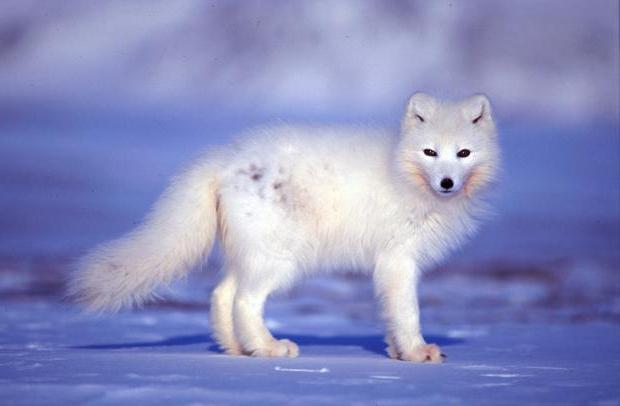
Seals and walruses
The most popular animals in the Arctic desert zone are seals. They represent a separate population, but have many subspecies. A characteristic feature of all seals is flippers, which replace the diverging hind limbs. They end in claws that allow mammals to easily move around snowy terrain. Among the most striking species of seals are the harp seal (the largest and most dangerous of all species), and the sea seal. The latter species is characterized by the smallest size, and at the same time all of its representatives are very mobile. But the closest relative of the seal is the walrus, which is also its danger. Walruses are much larger in size, have sharp fangs with which they cut through the ice and get their food from the sea. They also need this tool for land hunting. They eat small animals, including seals. 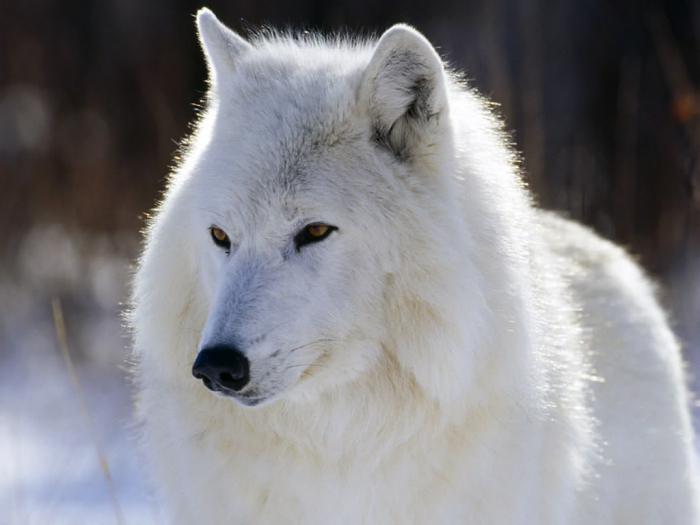
Bears and wolves
The brightest animals in the Arctic desert zone are polar bears. They have an exceptionally white color and dense coat, which allows them to survive the eerie cold both on land and under water, which is simply icy. Besides the fact that the bear is the king of the Arctic, he is also the most dangerous predator here. It eats land animals and mammals, which are smaller in size. It is also dangerous for fish and animals that live in the sea. Polar wolves are not so dangerous, but no less ferocious in the North. They are very beautiful, white or brown in color and live in flocks of up to 9 individuals. Their prey is Arctic foxes, deer, sometimes small seals, as well as all other land animals that are smaller in size. 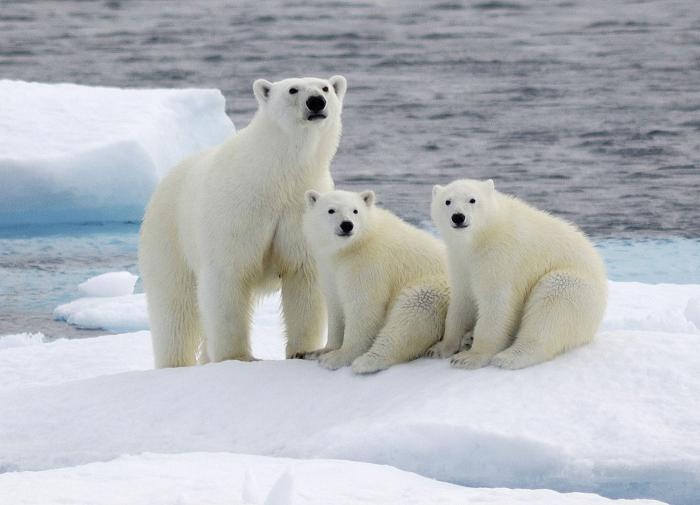
Red Book of the Russian Federation
The animals of the Arctic desert zone listed in the Red Book are almost all of the species that were named above. But in order to have a more specific idea of what kind of inhabitants of the northern latitudes need to be protected with special attention, we will list them again. The red book contains a polar bear, a walrus, a seal, and a polar fox. Of mammals that live in aquatic environment, the Red Book includes narwhals, killer whales, and for some time now also belugas. In addition, many species of birds are included in the pages of this book. These are rose and white gulls, peregrine falcon, cran-throated goose, small swan and others.
Afterword
Almost all animals of the arctic deserts have been listed above. In Russia, all these species have been inhabiting since the formation of the climate on the planet, and similarly the picture is northern regions Alaska as well as Greenland. The fauna of this snowy world is very unique, not like another, and most importantly, it is dying out. Therefore, the governments of all countries to which these animals are related, carefully guard them. They cannot be hunted, exterminated and infringed upon in every possible way.
The northernmost natural zone of the planet is the Arctic desert, which is located in the latitudes of the Arctic. The territory here is almost completely covered with glaciers and snow, sometimes there are fragments of stones. Here most of the time winter reigns with frosts of -50 degrees Celsius and below. There is no change of seasons, although during the polar day there is a short summer, and the temperature during this period reaches zero degrees, without rising above this value. In the summer it can rain with snow, there are thick fogs. There is also a very poor flora.
Due to such weather conditions, animals of the Arctic latitudes have high level adaptation to this environment therefore they are able to survive in harsh climates.
What birds live in arctic deserts?
Birds are the most numerous representatives of the fauna that live in the zone of the arctic deserts. There are large populations of rose gulls and guillemots, which feel comfortable in the Arctic. The northern duck, the common eider, is also found here. The largest bird is the northern owl, which hunts not only other birds, but small animals and young large animals.
Pink seagull
Common eider
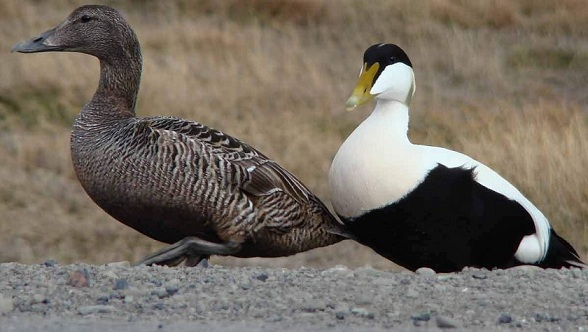
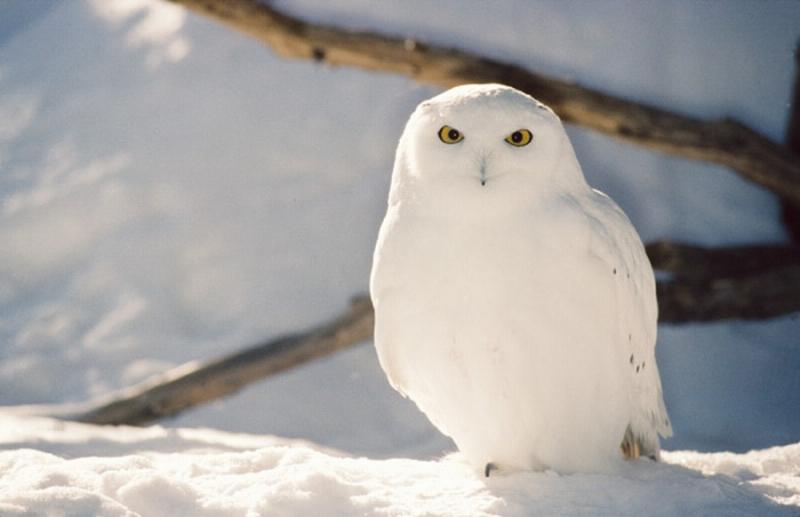
What animals can be found in the Arctic?
Among the cetaceans in the Arctic desert zone, there is a narwhal, which has a long horn, and its relative, the bowhead whale. Also, there are populations of polar dolphins - beluga whales, large animals that feed on fish. Even in the arctic deserts, killer whales are found hunting various northern animals.
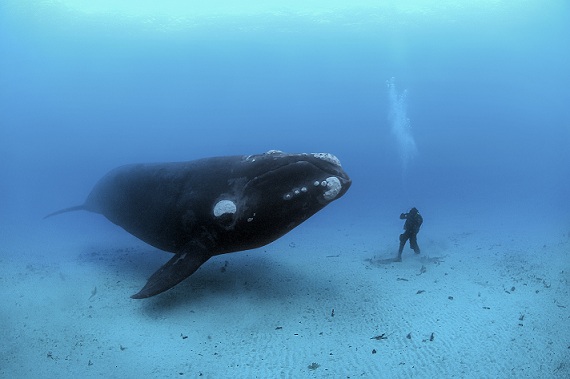
There are numerous populations of seals in the Arctic desert, including harp seals, mobile ringed seals, large sea hares - seals, 2.5 meters in height. Even in the vastness of the Arctic, you can find walruses - predators that hunt smaller animals.
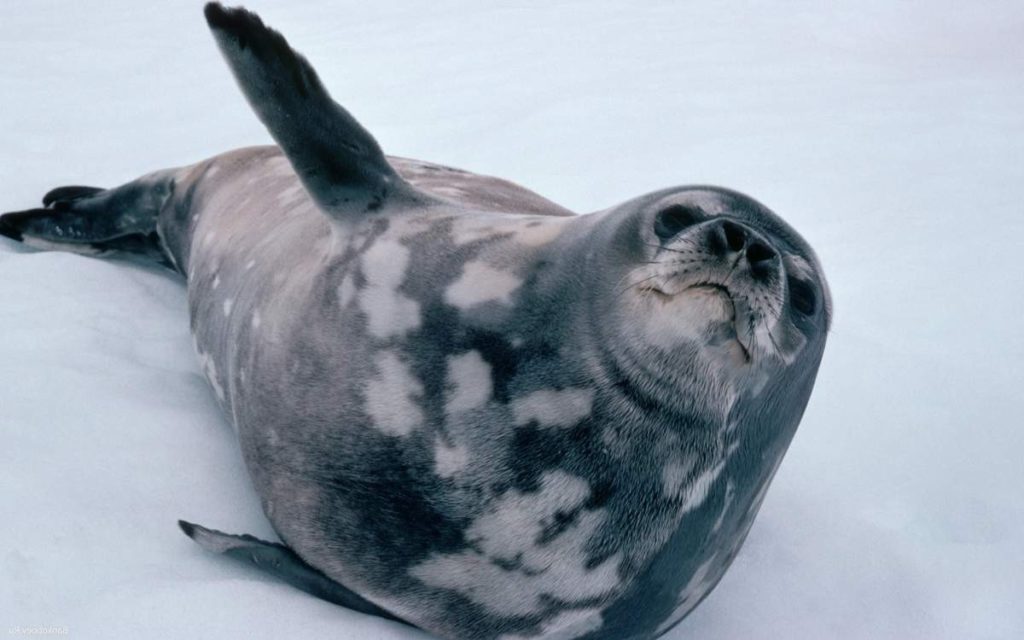
Among the land animals in the Arctic desert zone, polar bears live. In this area, they are excellent at hunting both on land and in water, as they dive and swim well, which allows them to feed on marine animals.
White bears
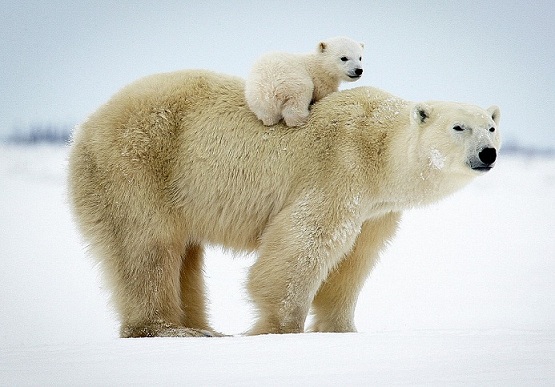
Another severe predator is the arctic wolf, which does not occur singly in this area, but lives in a flock.
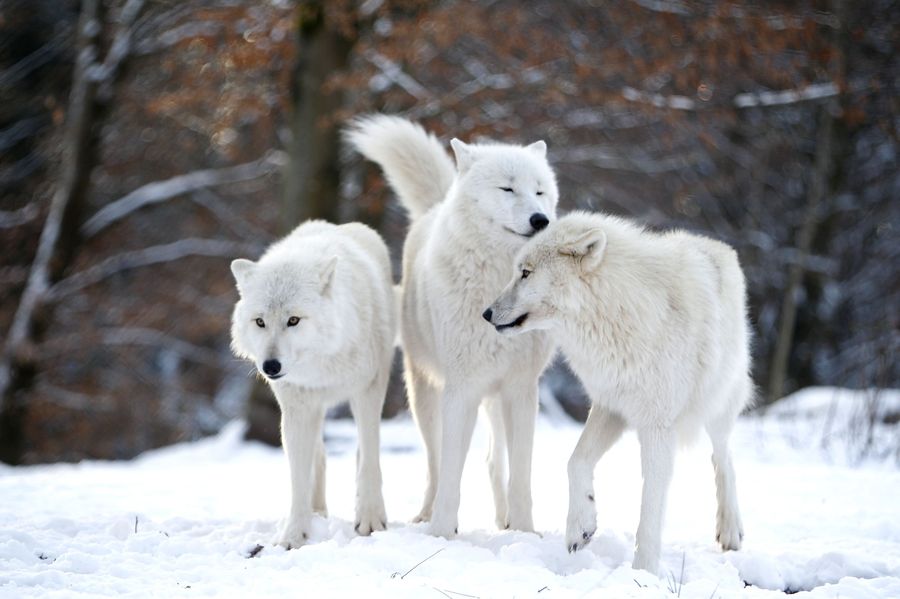
Such a small animal as the Arctic fox lives here, which has to move a lot. Lemming can be found among rodents. And, of course, there are large populations of reindeer here.
Arctic fox
![]()
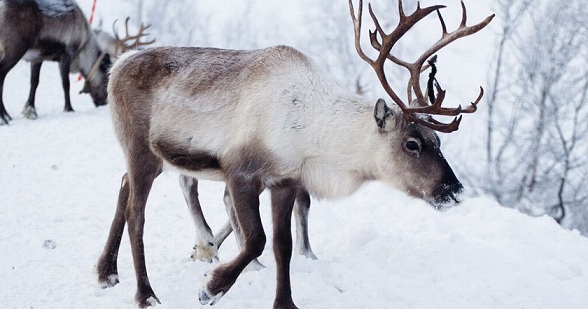
Adapting animals to the arctic climate
All of the above species of animals and birds have adapted to life in the arctic climate. They have developed special adaptive capabilities. The main problem here is keeping warm, so in order to survive the animals must regulate their temperature regime... Bears and arctic foxes have thick fur for this. This protects the animals from severe frost. Polar birds have loose and tight plumage. In seals and some marine animals, a fatty layer forms inside the body, which protects from the cold. Particularly active defense mechanisms in animals are manifested with the approach of winter, when frosts reach absolute minimum... In order to protect themselves from predators, some representatives of the fauna change the color of their fur. This allows some species of the animal world to hide from enemies, while others can successfully hunt in order to feed their offspring.
The most amazing inhabitants of the Arctic
According to many people, the most amazing animal in the Arctic is the narwhal. This is a huge fish that weighs 1.5 tons. Its length is up to 5 meters. This animal has a long horn in its mouth, but in fact it is a tooth that does not play any role in life.
In the reservoirs of the Arctic, the polar dolphin, the beluga, is found. He only eats fish. Here you can also meet the killer whale, which is a dangerous predator that does not neglect either fish or larger marine life. Seals live in the arctic desert zone. Their limbs are flippers. If on land they look awkward, then in water fins help animals to maneuver at high speed, hiding from enemies. Relatives of seals are walruses. They also live both on land and in water.
The nature of the Arctic is amazing, but due to the harsh climatic conditions not all people want to join this world.




